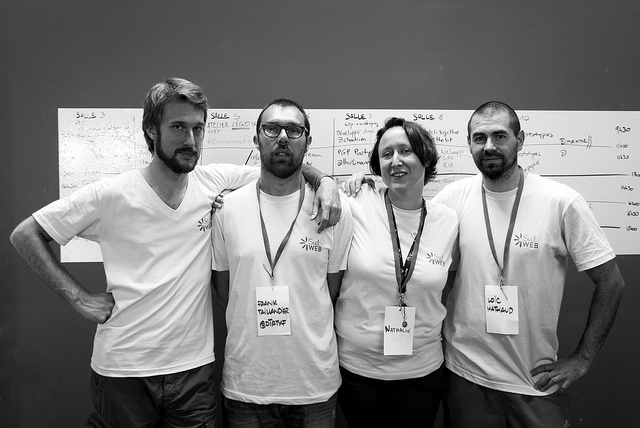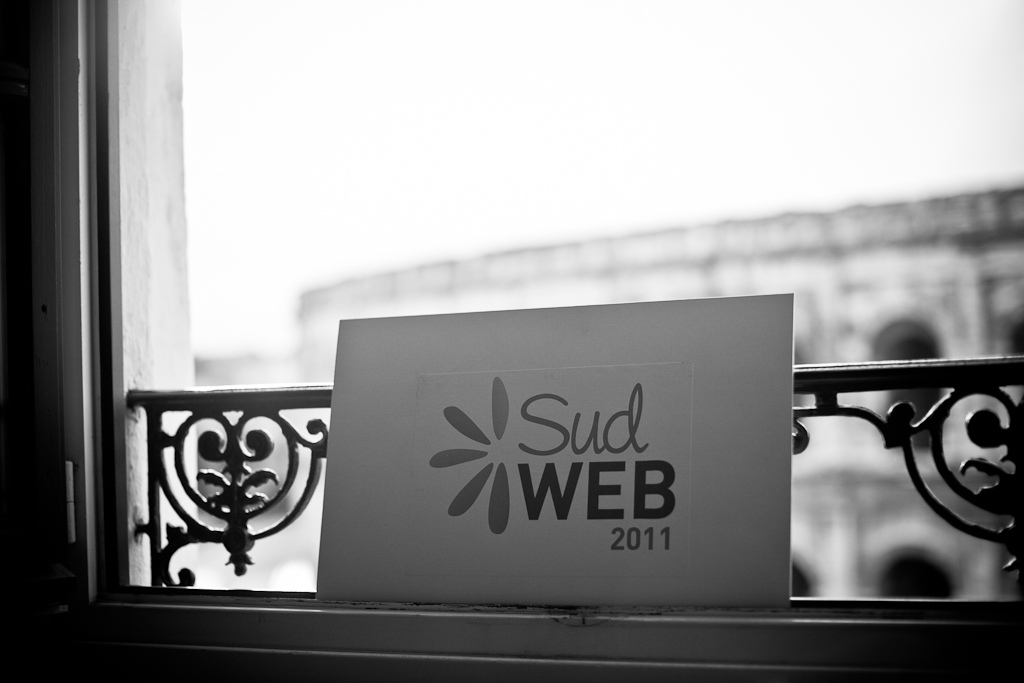
69 months of Sud Web
What is better than 50 shades of Grey? 69 months of conference organisation. Almost 6 years!
Why leaving while being one of the founding members? And what did I learn throughout our yearly iterations? This is what we will focus on.
§tl;dr
Working on a non-profit event project for years was both an experimental lab and a source of self development.
§What is Sud Web?
Sud Web was born in October 2010 in the midst of a French web conference which taught me so much. A few folks stood up and asked for help to organise a conference in the South of France. Everything had to be done in less than 6 months. Challenge accepted!
At the time, there were not so many web related events happening outside of Paris. Part of us shared a common vision of creating something slightly different, less focused on the latest tech nor the latest spec.
Sud Web was born like this, as a yearly conference about web development and web design, moving from town to town, bathing in the good spirit of the South of France.
§Our choices
We started with implicit choices but strong ones: favouring feedbacks and experience sharing rather than listicles (e.g.: 10 ways to be an awesome {developer, designer, etc.}) and name dropping talks (e.g.: {React, HTML5, etc.} for the win) within a voluntarily small audience (120 tickets, including discounted fares for students and job seekers).
We wanted to reflect our intuition through the baseline of Sud Web: savoir-faire et faire savoir (a pun around know-how and how to make it known). We identified our former intuition and transformed them in explicit values after two or three editions.
We also wanted to design the conference over two days: one day of talks and one day of workshops based on the OpenSpace principles. There is nothing better than enabling and empowering people to organise hands-on sessions based on an inspiring first one.
In the end, we created and learned to shape the conference we wanted to attend every year, content and format included.
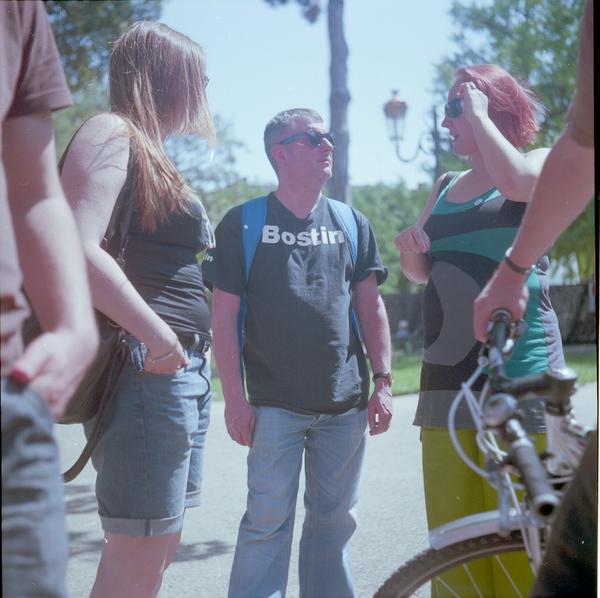
§From infancy to maturity
We learnt how to work as a distributed team of volunteers but we also evolved as part of the non-profit organisation.
We indeed started as a spin-off of a web conference and after two editions, it was clear speaking about newer tools or better tools did not solve any of the day to day problems.
As a consequence, we wanted to put even more emphasis on experience sharing and on topics around the web.
Content diversity is hard to achieve through a call for speakers selection process. As a consequence we started to curate some of the speakers after three editions. It gave us free hands to identify and give the opportunity to bring on stage people who were not aware of Sud Web and we thought who could bring a tremendous knowledge to the delegates.
People found it weird the first time we did it (and because this is France we were obviously flagged as non-democratic in our selection process). Now attendees are happily surprised it works so well.
Curation itself does not make things better on its own. We opened the range of topics covered during the day of conferences: law, arts, psychology, fashion design, digital humanities etc.
It enabled us to move and recenter from what we do to why do we do it and what do I want to be. Asking more long term questions than giving short term answers. Treating people like evolving individuals rather than hamsters in a wheel.
Curation means more work but it coincided with the time when the organising team shrinked down to three people and a half, we leaned towards simplification. It means we decided to limit the call for speakers to lightning talks and workshops, then to lightning talks only — thus making the second day facilitated and fully self-organised (instead of being bootstrapped by a few selected workshop proposals).
We experienced that a focused and responsible organisation of 4 people is more efficient than one of 8 or 10. It was shockingly surprising how few/none arguments we had nor tension at all we faced during the preparation logistics. Maybe this is when we realised how spending efforts to empower attendees was more rewarding than trying to make everything pixel perfect.
When we were only the four of us, we had to focus on the essentials. We realised how much shite pumped our time and energy whereas it was unrelated to the conference itself: the website design and codebase (we moved to plain 'ol HTML pages before switching to an HTML generator), identifying a goodies provider (preferably ethical or involving craftsmanship) etc.
We made the decision that if we had to add something new, it had to do with the content. And a conference content means what speakers say and what attendees do (think of artefacts).
And in term of doing, we started shaking attendees by introducing hands on talks:
- breaking the ice of drawing in 2014;
- making pixel art with paper and pencils in 2015;
- making your own zero waste cable bag in 2016.
One of the content which evolved the most is the debate talk format:
- a round table in 2011;
- open questions session in 2012;
- an interactive talk in 2013 — in the beautiful Avignon pope’s palace;
- a hacked talk in 2014 — hacked into a giant Q&A about what makes us a good person;
- a non-recorded open mic in 2015 — about how people feel about their life at work;
- nothing in 2016 as we lacked of time — although we wanted to try small groups urban perambulation followed by a retrospective.
We learned and moved from web technology to goodwill. Sadly, bienveillance is a term which does not translate well into english — which has way better and clear words on so many other aspects of life.
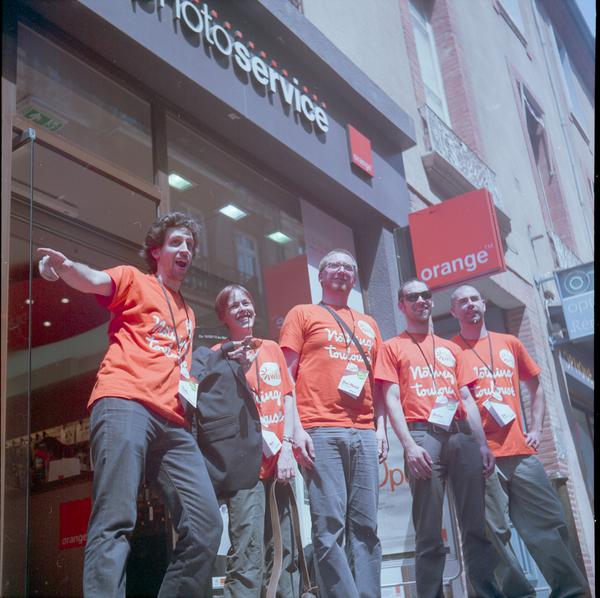
§What I am proud of
I am really proud of what we achieved over the past 6 years. Proud of all our team work. Proud of all these great social times when we gathered to triage the call for speakers submissions or ran the retrospective after the conference ended. Proud of the smiles and signs of well being attendees gathered with them back home. Proud of the speakers who spoke for the first time and received their first and already biggest clapping hands ovation so far. Proud of the people who trust the conference, once or many times.
I am also proud of a few twists I delicately (I hope so) injected into the conference DNA.
§Speaker curation
From the many conferences I attended, I noticed the outstanding quality feeling I got out of them when part of their agenda was curated.
Since day one, I spent most of my efforts to influence the content of the conference. Most notably by asking and helping a few people to submit a talk proposal. I was in a good position to offer to try something a bit different by running the curation of the fourth edition in 2014.
I tried as much as I could to share my motivations for every speaker I wanted to invite on stage in order to receive a buy-in from the rest of the staff. It happened the Sud Web team always trusted my choices, even if sometimes they could really be dubious about some of them — fashion design at a web conference really?
I think curation helped us to make bold statements (about emotions, about meaningfulness etc.), to build our very own identity based on strong values and to create questioning content rather than solely broadcasting active speaker minds.
Curation is definitely a great tool to explore areas of interest and to tell a coherent story throughout the day via a breadth of topics which help people to think better, to look at things differently or to raise their awareness.
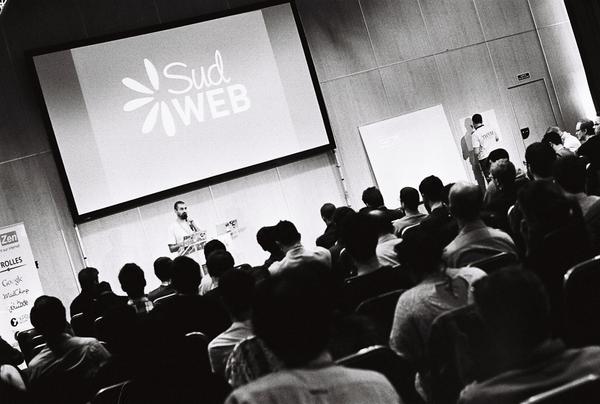
§Tooling
I was interested in bringing good speakers in order to construct a good audience. By doing so, I realised my software development skills could be useful to improve the organisational side of things.
We started with — and since kept using — Google Forms as a way to submit proposals during the call for speakers. Reviewing hundreds of proposals in Google Spreadsheet is nor white nor black: it is great to collect votes but it is terribly poor to visualise long paragraphs
I gradually iterated over a single page app: it fetches the Spreadsheet data via Google Spreadsheets (undocumented) JSON API and populates a user interface with the submissions. And provides all the needed comfort to work during the yearly submissions review day.
Its source code can be found on github.com/sudweb/talks.
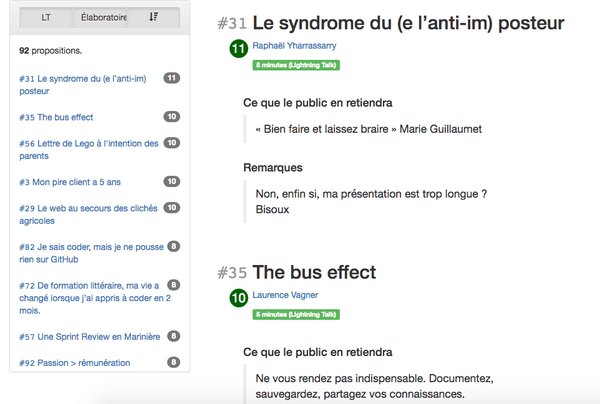
Since 2015, Sud Web displays not only the speakers list but the attendees list on the website. I wanted to provide a feeling of belonging to the attendees, as well as a nice entrypoint to browse the faces of everybody. Conferences also have great people on the audience side, so better to broaden the spotlight to the entire crowd — have you ever been to a conference because of a delegate rather than a speaker?
Well, it happens at Sud Web and it did not require much more than a combination of curl and jq to gather the data from the ticketing service API and to consume them with a static pages generator system.
§Finding a voice
Sending emails to speakers and attendees was part of our tooling needs. We use Mailchimp for that — and they have been kindly sponsoring Sud Web for five years.
This time I brought some user experience by iterating over the content after listening to feedbacks and hearing over conversations in the corridors. A few improvements were brought to the mailings:
- bare bone layouts for speakers communication
One to one conversation implies a plain text email or slightly formatted HTML email. I moved the fancy template to a monochrome, one logo and one column layout. The idea was to be as close as possible to a conversational email but emitted by an organisation which cares about its recipients. The email is broadcasted to a group of people but you read it as an individual. - what is paid by Sud Web and what is not
Some conferences do not include food, some of them offer a round of drinks and some of them do pay for everything — as a speaker it is hard to know what to expect and it is frustrating to have to take out a debit card whereas they were invited to a party. - building a safe zone
I assumed people did not know much about Sud Web when writing emails. Also, as a speaker, you go through quite a stress to think about and write about your talk, even if it is a five minutes lightning talk. I assumed I had to clear every single areas of stress each time a dispatch was sent: what are we doing, when are you going to receive the next message, rehearsal schedules, what do we expect from you etc.
As a consequence, open rate increased and we received more responses thanking us and expressing relief. - print me out
A direct consequence of the previous points, the ultimate email we send contains everything a speaker has to know before boarding on their journey — from home to conference to stage to home again.
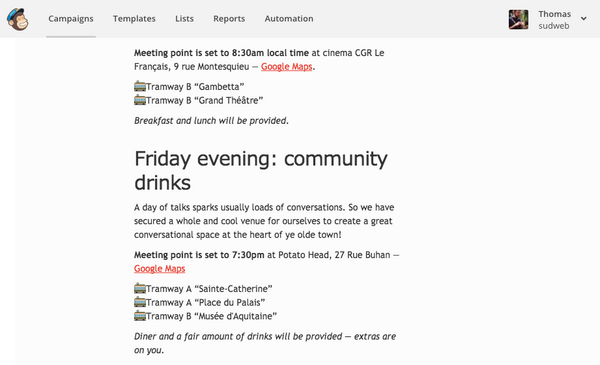
Email is an incredibly powerful tool because of its highly personal consumption experience. I used this channel to build confidence between Sud Web and our speakers (and attendees).
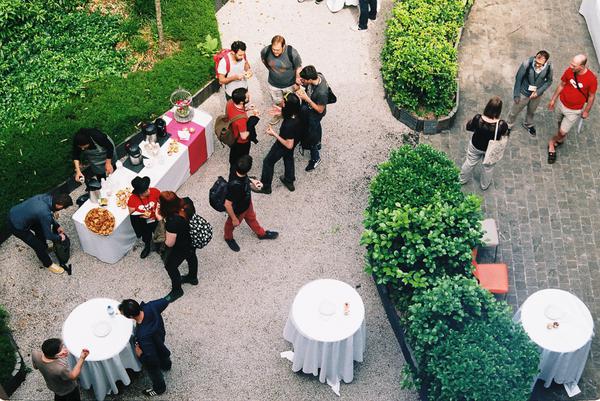
§Lessons learnt
Speakers are content.
Attendees are content.
Emails are content.
The biggest lesson is a conference is all about content. And we are responsible for the content we put on stage. Stuffing an agenda with rockstars gives a totally different conference than mixing experienced and novice speakers. And a different ambiance too.
We cannot encourage people to be genuine if the line up is designed to help us sell hundreds of tickets. We cannot encourage different work/life practices if we do not show examples of what happens elsewhere.
So we learned to treat speakers as attendees. Same social events. Same conference experience. But with some variation in the attention we pay to their experience — they are stressed and give a lot of efforts in order to be happy of their presentation.
This edition has been amazing. It is going to be difficult to make it better next year!
Some attendees and organisers said something similar to the above quote. It is easy to be scared and blocked by the idea of it. Why joining a team for which one has no idea on how to make it better?
Because we never thought in these terms but rather followed the following (and implicit) principles:
- if we can make something simpler, let’s make it simpler;
- if we have clear improvement, let’s improve it;
- if we want to experiment something, let’s experiment;
- the programme has always been designed with continuity in mind — it feels better only because we carry over the thoughts gathered back from the conference.
The content of the talks impacts the submissions of the next call for speakers. In parallel, those who did multiple submissions over the years start to understand what works and what doesn’t.
On the other hand, the curation process sets new horizons and topics whilst it connects or follows up with previous talks.
I do not think we ever had in mind a strong ambition to create a community. However we accidentally created a culture. By gradually shifting from the technicality to what matters to us, people working in the web. People. Because our issues and because our dreams are not specific to the web industry.
Kevin Goldsmith explained very well why creating a culture is more important than everything else in his talk at Sud Web 2014:
The “last” lesson learnt is what organising a conference is. We started as a large group of individuals, mostly freelancers. Everybody had an opinion and a favourite tool. We had lengthy conversations about which CMS or which ticketing system to use.
We learnt that organising a conference was not about building a website, designing icons or lobbying for a tool we like but it is about designing an experience suitable for the group as a whole.
We organically moved from a siloed organisation to a team of individuals responsible for the tasks they were picking or offering to add to the backlog. One person has a manual task to do in a few amount of time? Two additional people come and help to automate the process.
The outcome of each edition became a shared responsibility — and a shared satisfaction.
§Why now?
One would ask why leaving an organisation, especially when there is no presence of a clash whatsoever?
Reasons are threefold:
- The conference is at its best — which means it is resilient enough to fail once;
- I want to spend my efforts on something else — six years is long enough and 2017 is leaning towards a leap change;
- I want attendees to feel responsible for what matters to them — one can’t change politics but one can get involved in a conference they love to attend.
We have not managed to both organise the conference and to self-reflect on ourselves at the same time. I think leaving would help to trigger the mutation. Not knowing how to do something means questions need to be raised to the group. Informations will eventually be shared and made available or reinvented in a suitable way for the current state of the organisation.
I also believe new joiners should join not because of their skills but because of what they want to develop in the organisation. Otherwise they will be too tempted to stay in their comfort zone and to entertain a silo.
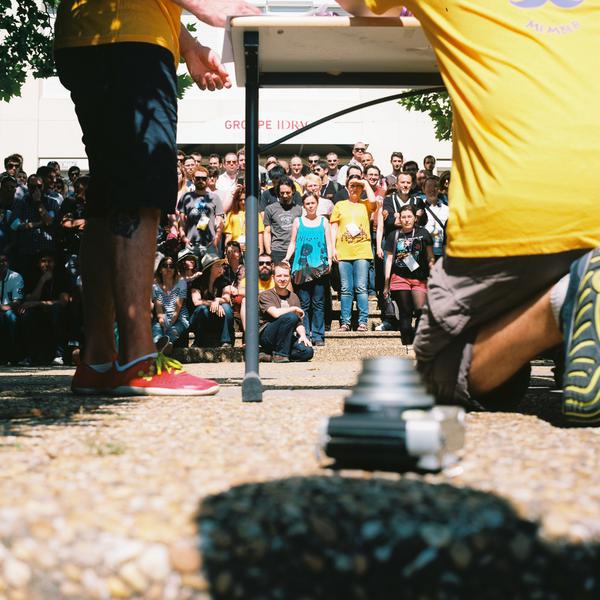
§Conclusion
Six years ago, I did not know what I was doing when I jumped onto the conference organisation boat.
Six years ago, I only had a hunch of the kind of conference I wanted to attend.
Thank you for the past six years.
PS: and because I know myself a bit, I know I will definitely iterate on something else one day or another. Maybe around ideas I have not been able to develop, yet.
